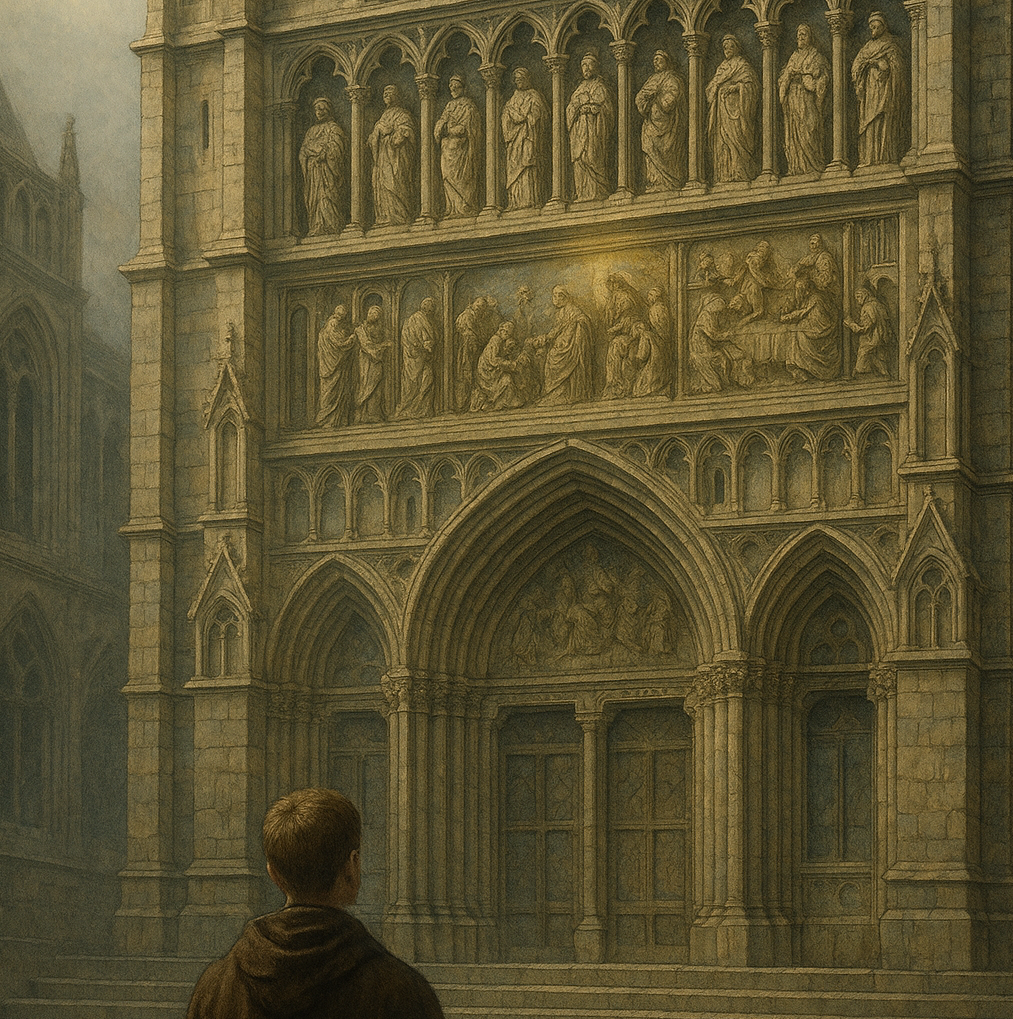From Stories to Storeys

How Buildings Became Narratives
On a misty afternoon in Rouen, you pause before a Gothic cathedral. From street level, your eyes climb the façade: a row of carved apostles stands above you, solemn in their niches; higher still, a band of panels shows the life of Christ, each scene unfolding from left to right. A shaft of late light glances off the stone, turning the figures momentarily golden. The tower bells begin to toll, and you realize you’ve been “reading” the building without a single word on the page.
In the Middle Ages, this was no accident. Each horizontal tier of the building was a chapter in a story, its carvings, paintings, or windows meant to be read — or at least interpreted — by everyone who passed. To live in a city like this was to walk daily inside a public library of stone, where meaning wasn’t hidden away but built into the streetscape.
Medieval façades as picture books
From the 12th century onward, the façades of important buildings—churches, guild halls, civic structures—often carried entire narratives in their design:
- Carved stone reliefs showing biblical episodes or the lives of saints.
- Painted wooden panels presenting moral allegories.
- Stained glass windows forming sequential scenes when viewed from outside.
These were not passive decorations. In a largely illiterate world, they were the city’s memory, conscience, and imagination—giving shape to what mattered and keeping alive the shared stories that bound a community together. People didn’t merely pass by these façades; they oriented themselves by them.
Etymology: from Latin to Middle English
The architectural sense of story comes from Anglo-Norman estorie, meaning both “history” and “narrative depiction,” rooted in Latin historia (“account; narrative; history”).
By the 14th century, Middle English used storie in two ways:
- A tale, account, or narrative.
- A level of a building—especially one adorned with narrative scenes.
The metaphor was natural. A storey wasn’t simply a physical tier; it was a layer of meaning, a vantage point in the unfolding account of the building and the life it contained. In both senses, story was something you ascended into.
British vs. American spellings
British English eventually distinguished storey for the building sense and story for the narrative. The -ey ending served clarity in writing. American English, in its 19th-century simplification of spelling, dropped the “e,” making story do double duty — a “ten-story building” and “a ghost story” look identical in print.
Where Storey Still Meets Story
Our glass towers may not carry saints in stone, but the instinct to place meaning in our façades has never vanished.
- Murals as urban memory — Cities from Philadelphia to Melbourne turn blank walls into vast canvases for community history and pride.
- Memorial walls and vertical remembrance — Names and dates etched in stone or steel create a narrative journey as you move physically along them.
- Digital façades and projection mapping — Buildings become screens for light shows and interactive art, telling stories in motion.
- Branded skyscrapers — Corporate headquarters project identity through design, materials, and light patterns.
- Vertical gardens — Green façades grow and change, marking the seasons like living chapters.
Humans flourish in the presence of story.
Even without carved reliefs, our cities still “speak” in storeys — some remembering, some persuading, some inspiring.
Language as living architecture
In medieval thought, a building was never mute. It instructed, warned, celebrated. To climb through its storeys was to move through layers of narrative — a journey in stone as much as in space.
We still live inside this truth, even if we notice it less. We need narrative the way we need shelter: to make sense of our world, to anchor us in something larger than ourselves, to remind us that where we stand has a past and a future.
So the next time you “go up a story,” pause for a moment. You’re stepping into an old tradition — one that remembers a time when walls spoke through images, windows taught in color and light, and every ascent was both an elevation of body and of mind.